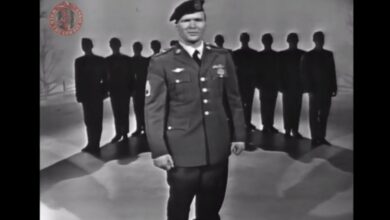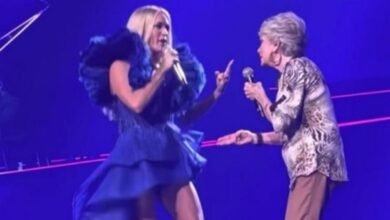Vince Gill wrote this song after his brother’s loss, but Kelly’s cover brought me to tears.
Kelly Clarkson’s rendition of “Go Rest High on That Mountain” goes beyond a typical cover; it serves as a deeply felt tribute that resonates with listeners from all walks of life. Written and originally performed by Vince Gill, the song poignantly reflects a farewell born from his own experience of losing a brother. Since its release in 1995, it has offered comfort to many who are grappling with grief. Clarkson’s approach to the song is not just a performance but an emotional homage that encapsulates the themes of loss, hope, and healing.
As the first winner of “American Idol,” Clarkson has made a name for herself as a formidable force in the music industry, recognized for her extraordinary vocal talents and authentic emotional expression. Her musical journey spans a variety of genres, primarily pop and country, which enriches her interpretation of “Go Rest High on That Mountain.” This diverse background enables her to explore the song’s emotional complexity with a depth that reflects her own experiences, adding a layer of authenticity to her performance.
From the very beginning, Clarkson’s version captures attention with its soft guitar intro, setting a reflective mood that invites the audience to contemplate. As she begins to sing, her voice conveys a sincerity that feels deeply personal. Through her performance, she pays tribute not only to those who have passed away but also to our shared experience of grief, fostering a strong connection with her listeners. This approach transforms the song into a collective expression of mourning, extending its emotional reach.
The transition into the chorus highlights Clarkson’s remarkable vocal range and emotional versatility. With each note, she masterfully shifts from delicate, vulnerable vocals to powerful, soaring crescendos. This contrast beautifully illustrates the coexistence of loss and hope, allowing the audience to resonate with both emotions simultaneously. It is this interplay of tenderness and strength that makes her performance incredibly impactful, evoking both tears and uplifting feelings in one moment.
The arrangement of the song significantly enhances its emotional depth. Accompanying Clarkson’s powerful vocals, additional musicians contribute layers of sound that create a lush musical landscape. Subtle orchestration of strings and harmonies enriches the overall experience without overshadowing her voice. This thoughtful balance keeps Clarkson at the forefront, allowing her heartfelt expression to stand out amidst the rich backdrop.
Her physical presence during the performance adds to the emotional weight of her delivery. Her facial expressions and body language align perfectly with the lyrics, reflecting the heartache and yearning that the song conveys. As she immerses herself in the music, her sincere emotional engagement captivates the audience, inviting them to share her journey of sorrow and healing. This authenticity strengthens the bond between performer and audience, deepening the collective experience of mourning.
As the final notes of “Go Rest High on That Mountain” fade away, a profound silence fills the air, charged with admiration and contemplation. The audience’s applause goes beyond a mere acknowledgment of Clarkson’s vocal prowess; it signifies a communal experience of grief and healing that she has masterfully expressed. This moment serves as a collective release, showcasing the healing power of music to connect and uplift individuals through shared experiences.
Clarkson’s performance embodies the broader healing potential that music can offer. For many, songs like “Go Rest High on That Mountain” can transcend mere entertainment; they become lifelines during tough times. Clarkson’s version offers a comforting embrace, guiding listeners through their personal struggles with grief while fostering a sense of solidarity. In this way, she transforms from a singer into a vessel for emotional expression and healing.
Moreover, Clarkson’s influence reaches far beyond this performance. Her ongoing presence in the music scene demonstrates her ability to resonate with diverse audiences through her authentic portrayal of complex emotions. With numerous successful albums and chart-topping hits, Clarkson’s career showcases her versatility and resilience, as she continues to evolve while staying true to her artistic vision.
Ultimately, her interpretation of Vince Gill’s poignant song encapsulates the universal language of music, illustrating its power to connect through both joy and sorrow. Clarkson’s authentic depth revitalizes the original track’s message for today’s audiences, inviting younger generations to discover its timeless beauty. Through her artistry, she cultivates a connection that transcends time, beautifully expressing the intertwined themes of grief, remembrance, and hope.





